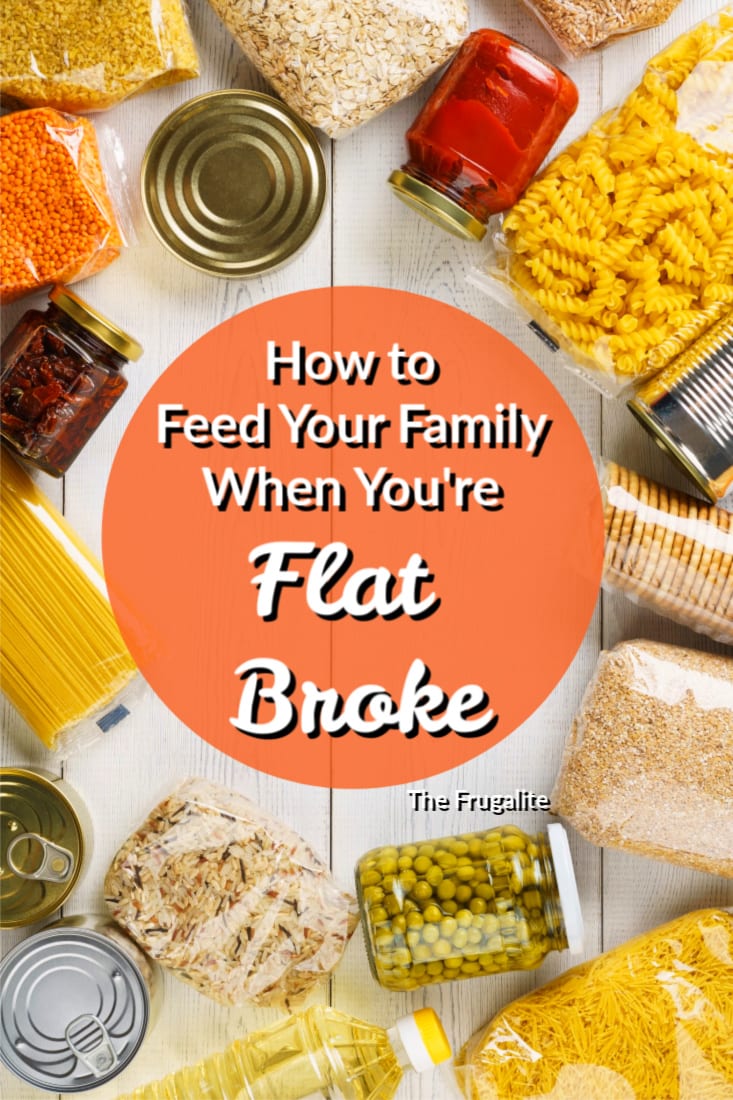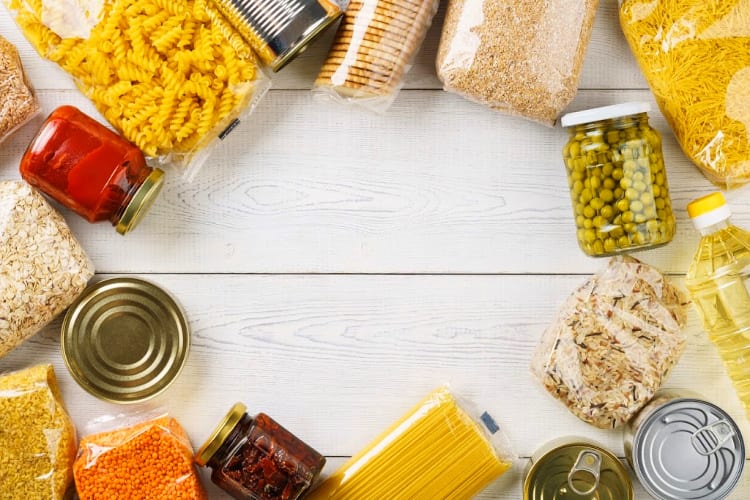(Psst: The FTC wants me to remind you that this website contains affiliate links. That means if you make a purchase from a link you click on, I might receive a small commission. This does not increase the price you’ll pay for that item nor does it decrease the awesomeness of the item. ~ Daisy)
What would you do if you suddenly need to prepare for a lean month ahead on a tight budget? Imagine you only had $400 or so to purchase all food and essentials for your whole family for a month. How would you cover the necessities?
Feeding your family when you’re flat broke isn’t easy but it can be done. This article was written to help anyone who finds themselves in difficult circumstances. I hope it helps you make it through the rough spot.
What to eat when your budget is severely limited
Here’s an article on dealing with a sudden financial emergency and here’s an article on surviving when you can’t pay your bills.
Now…about the stuff you need to buy. The lists below are specifically food, but keep in mind that there will be other needed supplies in the month too. Don’t forget about toilet paper, soap, shampoo, feminine hygiene products, toothpaste, dish soap, and any other essentials that your family may require.
When choosing what to purchase (and how much) consider the appetites and preferences of your family. Yes, even when money is tight, you can purchase food your loved ones will enjoy. You aren’t being punished – it’s just a rough spot.

You can buy this cookbook for as little as a dollar. If you can spare a little more to help out the website, we’d appreciate it. Go here to name your own price.
If you would like to purchase a PDF copy, go here. If you’d like the book in paperback, go here.
The book has loads of thrifty recipes and leftover ideas to reduce waste, as well as some shopping tips for getting through a lean month or two.
Where to shop
Remember, all grocery stores aren’t created equally. In every area, there’s always a “cheap” store. I find that in my part of the world, Food Lion and Walmart are a fraction of the price of Kroger, even with the sales. Walmart has inexpensive groceries in most areas.
Also, check out places like Aldis and Lidl. Some items that are name brand can be purchased at dollar stores and liquidation stores. Go to the least expensive place around for your shopping trip.
Some frugal food tips
Your menu this month may be a little different than what you’ve been used to before. Food may take more hands-on time to prepare.
- Cook from scratch. Remember when you’re buying food, either you’re doing the work or you are paying someone else to do the work. This month, you’re going to need to do the work.
- Stretch your ingredients. Be ready to stretch your ingredients by making soups, stews, and casseroles.
- Go with Cheap Eats. Cheap Eats are very low-cost foods to fill in the gaps in your budget. Learn more here.
- Don’t plan on eating low-carb this month. Unless, of course, you have a health condition that requires a low carb diet, plan on adding more grains and starches to your diet during a rough spot.
- Use your leftovers. Plan to use every single bite of food, including small amounts of leftovers. Here’s more on using up your leftovers.
- You probably won’t be able to eat organic. If you normally eat nothing but fresh, organic goodness, this month is going to have to be different. If times are really really tight, you are going to need to loosen your standards to survive.
This article talks about making healthy choices when you’re broke but if you are rock bottom broke, you may have to go even cheaper. Don’t worry about that during this tough time. Just make the best choices you can while still staying fed, okay?
Protein
When you’re broke, protein is going to be the most costly part of your menu.
- Meat: When your budget is super tight, don’t expect meat to be the main dish. I’m not saying you have to go vegetarian, but calorie for calorie, meat is very expensive. Use less meat than you normally would and make it an ingredient instead of the star of the meal. Go with less expensive cuts and cook them for a long time: stew beef, ground beef, chicken quarters, etc., are much less costly.
- Eggs: Eggs are a very inexpensive and healthy source of protein. Walmart has huge flats with 30 eggs for a very reasonable price. I suggest you grab a few of those and think about breakfast for dinner.
- Beans, beans, good for your heart. I absolutely love beans and strongly recommend them. Proper soaking and rinsing can reduce the resulting flatulence. Go with dried beans instead of canned for greater savings. If your family members don’t like beans, they might prefer refried beans or bean dip. Worst case scenario, you can puree cooked beans and add them to a soup.
- Peanut butter. Peanut butter is a tasty protein source and most kids love it. (Assuming there are no allergies, of course. ) Grab a huge jar and if possible, go for one that is more natural. Skippy and Jif both have a line of natural peanut butter without a whole lot of additives.
- Canned tuna: Beware of eating this stuff non-stop because of high levels of mercury, but some canned tuna will add much-needed protein to your menu.
- Lentils and split peas: Both of these are high in protein, dirt cheap, and easy to turn into delicious soups.
Fruits and Vegetables
Produce is a very important part of a healthy diet. Without it, you’re at risk for all sorts of deficiency diseases. When shopping once a month, plan to eat your fresh stuff early in the month and then move on to your frozen or canned goods.
- Apples: If the price is reasonable, grab a large bag of apples. This will provide you with some fresh fruit.
- Applesauce: This is a great addition for later in the month when the fresh stuff is gone. To save money, look for large jars of applesauce instead of the little individual packets for lunch boxes. Go with unsweetened applesauce.
- Canned fruit: Get fruit canned in the lightest syrup possible, or fruit canned in juice. Just because you’re broke doesn’t mean you need to eat 10 pounds of sugar per day, right? Canned fruit is a nice addition to pancakes, waffles, or oatmeal. Reserve the juice for baking.
- Overripe bananas: If your store has a last-day-of-sale bin for produce, you may be able to grab some overripe bananas. Get these and take them home for banana bread.
- Carrots: I’m not talking about baby carrots here. I’m talking about those huge bags of grown-up carrots you’ll need to peel and slice yourself. Remember earlier when I told you that you’re either spending time or money? Carrots are a perfect example of that. Peel them, slice them, and keep them in a bowl of water in your fridge for yummy snacking.
- Onions: A big bag of onions will help you flavor up your home cooking this month.
- Garlic: Sometimes it’s cheaper to buy garlic already chopped up in a jar. Grab enough garlic to spice up your food over the course of the month.
- Cabbage: Depending on the time of year, a few heads of cabbage will get you far for very little money. You can use cabbage in coleslaw, salads, soup, or casseroles. You don’t need to get fancy – just go with the plain, ordinary green heads of cabbage if they’re the cheapest.
- Canned tomatoes: My favorite canned good is canned tomatoes. I like to get a variety of crushed and diced ones. These can be used for soups, chili, casseroles, and sauces. Canned tomatoes are a nutritional powerhouse.
- Frozen vegetables: At my local grocery store, I can get bags of frozen vegetables for a dollar each, and sometimes less. If you have the freezer space, this is the way to go. I suggest you grab at least 30 bags of veggies that you know your family will enjoy. Our favorites are peas and carrots, green peas, corn, cauliflower, broccoli, chopped spinach, Brussels sprouts, mixed vegetables, and green beans. With an assortment of frozen vegetables, you can make all sorts of great stuff.
- Whatever is in-season: Every season, there are fruits and veggies that are at their ripest and least expensive. What is in season depends on when your personal financial catastrophe occurs. Here’s an article on in-season winter veggies.
It’s important to get enough produce for 2-3 servings per day at the minimum. I know all the health experts tell you 5-8 servings but you may not be able to swing that. Also, potatoes would really be considered a carb but since you find them in the produce department, I added them to this list.
Dairy
If you consume dairy products on a daily basis, you’re going to still want to consume dairy products when times are tough. (Cream for your coffee, milk for cereal, a beverage for the kiddos).
Generic milk by the gallon is your least expensive way to go for this. You can make all sorts of things from your gallons of milk, like homemade yogurt and cottage cheese. (Instructions are included in the book.) I suggest you put aside enough cash to be able to pick up a gallon of milk weekly. If you don’t already have powdered milk, this isn’t the time to buy it. It tends to be a lot more expensive than fresh milk.
Milk with lower fat can be frozen. Be sure to remove at least one cup of milk from your gallon jug to allow room for expansion. This works best with skim milk. Any milk with fat will need to be shaken each time you use it.
Grab cheese by the block for the least expensive option. Because we really enjoy cheese, I pick up 2 large blocks for a month. I cut each one in half and package them up separately. I freeze 3 and keep one in the fridge. Remember, cheese is a condiment during difficult times, not the main course. You simply cannot afford cheese and crackers for dinner.
Carbs and Grains
I know this is a wildly unpopular ingredient these days, with all the low-carb and keto diets out there, but grains are the great stretchers of your pantry. You can take one serving of leftover chili and feed your entire family with it when you mix it with rice and perhaps a little bit of cheese.
Buy your grains in the biggest packages possible for the most savings. Forget about “instant” anything – these items are often totally stripped of nutrition, and again – you are spending time, or you are spending money. Here are some of the grains to look for:
- Brown rice
- Pasta
- Oats
- Quinoa
- Barley
- Flour
- Cornmeal
There are lots of other grains, but these are inexpensive, versatile, and easy to work with.
And don’t forget the humble potato. A couple of bags of potatoes can get you through a rough time. Potatoes are filling, can be cooked in a lot of different ways, and most folks love them. Leave the peel on for added fiber. Store them in a cool, dark place away from onions for the longest life. Even when they’re sprouting eyes, you can eat them though – just cut out the sprouting parts.
Basics
To turn your raw ingredients into meals, you’ll need a few basics, too.
- Baking soda
- Baking powder
- Yeast (if you are going to bake bread)
- Spices
- Sugar, Syrup, Honey
- Fats (Cooking oil, shortening, butter, lard, etc.)
- Vinegar
- Salt and pepper
How much should you buy?
This is the tricky part. How much to buy has a lot of variables and only you can identify them.
- What do you have on hand?
- How big is your family?
- How hungry is your family?
- How picky is your family?
- How long do you expect the budget to be tight?
The best option is to do some meal planning before you go shopping. This should help you identify how much you need for the main meals. Don’t forget to add extra for lunches and snacks!
Getting through a rough spot
I know it’s scary to face financial problems, but you will get through this. I know it feels like the rug has been yanked out from under you. But the way you handle these difficult times is the way you will handle a disaster that is even more serious and long-term. Your determination to get through it means everything and I hope that my book can provide you with some of the tools you need to make it happen.
I know you can do this.
In the comments, does anyone have suggestions for other cheap and thrifty ingredients that folks on a limited budget should pick up?












31 thoughts on “How to Feed Your Family When You’re Flat Broke”
Yesterday I went to Kroger to buy pork ribs, and as I walked by the clearance meat area, there was a beautiful tray of sliced round steak marked down from $25 to $10! The date on it was good for another couple of days, so I grabbed it and brought it home to freeze. That $10 worth of meat will make several meals for the two of us. Looking forward to some swiss steak and pepper steak. Since meat is usually the highest priced item in a meal, spending $2 per meal on meat means I can feed two of us for less than $5, and most of the time I already have the other ingredients in my pantry.
Yesterday I stopped at Smiths, a Kroger owned store, to get a few things. In the discounted meats I found three packages of London broil. $2.57 lb. Each package between 2.33 and 2.75 lb. All preseason. I cooked one in a bit of butter and coconut oil. When I b turned it to cook the second side I added one diced onion, 2 yellow crookneck squash from the garden, one small hot pepper and a small sweet peppers also from the garden. 10 minutes per side for rare. We ate the vegetables and close to 1/2 lb of meat. The rest of that piece of meat will now be diced and cooked with potatoes, onion, and carrots for thick beef stew. That will make us several more meals. I froze one piece of meat and I’m canning the other in 1/4lb sections. I pounded them thin to tenderize them more and seasoned the broth on them. They can be patted dry, breaded and quickly fried or added to soups later. The broth can become gravy or soup
Great lists here! When we were starting out and our kids were small I baked a loaf of bread almost daily in a bread machine. My friend kneaded his by hand because it helped with his stress problem. Either way the cost is minimal, and the bread can be used for a variety of foods. Have French toast, or a soft boiled egg over toast, or a toad in the hole (an egg fried in a hole in the toast) in the morning. Peanut butter and jelly, grilled cheese, or egg salad for lunch. Buttered bread with supper. Cube and dry the bread for the base of an egg casserole or home made stuffing. Try to get yeast in bulk. A years worth is under $5 at Sam’s Club – if you don’t have a membership do you know someone who does?
Another thing I cooked was homemade spaghetti sauce. A 106 oz can of store brand tomato sauce is 3.32 this morning at Sam’s. Walmart is more expensive with brand names, but I’ll bet Aldi’s is considerably cheaper. Add chopped onion, some of your garlic, basil, and oregano (or Italian seasoning) and simmer until thick. Millions of recipes online. Add browned hamburger if you can. Freeze in smaller containers and you’ll get several meals out of that can.
Turkey can be an inexpensive meat with potential for a lot of meals. Make bone broth for soup with the carcass. (It’s my favorite soup!) Again, tons of recipes online if you’ve never made turkey or broth.
Good luck to you! Most of us have been through this at some point in our lives. You’ll figure it out. As last resort you can do what my friend did in their lean time after lay offs. They ate a lot of elbow macaroni with ranch dressing or in tomato soup. Not the best meals but meals like that filled up her kids until they got jobs.
If you like pasta, it’s massively cheap, as most of us know. There’s things like spaghetti and all the different boxed pastas out there. As cheap as ramen is, I wouldn’t recommend it because of the various additives, but regular pasta can be quite filling. If you live near a Food City or other low cost grocery store, sometimes you can get little bags of noodles for fifty cents each or so, or even less on sale.
A note about supermarkets: Go to the ones in the crappiest parts of town that you can find. Many times they’ll have bargain basement deals you won’t find in the nicer parts of town. Also it can be worth going to farmer’s markets, especially at the end of the day when farmers are likely to discount stuff so they don’t have to take it home.
If you have Nextdoor.com, ask your neighbors if anyone has fruit they don’t want to go to waste. Around my area you can get all kinds of citrus in the wintertime, and when I was a kid we used to pick apples and filberts from yards, with permission. You may not have that option but it’s worth checking into if you’re really hungry.
Dear Ms. Daisy,
Although my life has not crashed yet, I want to compliment you on your always practical articles on how to get by.
Thank you so much!
William McGrath, Waiehu, Maui
Thank you so much, William!
The bigger Dollar Tree stores have not only canned goods, but dry beans, pasta, lots of canned goods, frozen meats, refrigerated juice, cheap coffee, tea, frozen vegetables and a lot of other things in the refrigerated and frozen sections. 99 Cent Only Stores also have some good deals including fresh fruits and vegetables as well as the same kind of food as Dollar Tree. You can eat surprisingly well. I do much of my shopping at a large Dollar Tree.
Beans and rice together make a complete protein, but you can vastly increase the nutritional value by sprouting the beans.
Spot on, Daisy!
The only thing that’s missing from your list is pet food. We try to budget that in first, as that is an expense you really can’t adjust, unless you’re buying “Chi-Chi Exotic Meats Ultra Premium Pet Food Now with 24 karat Gold Flakes in every can!” In which case, Fido will probably be just as happy with the cheaper stuff. Just mix it with their premium stuff to wean them off gradually. If you absolutely must feed your pets all meat premium food, buy the ingredients and make it yourself. It’ll be fresher and cheaper if you buy ingredients on sale.
Oatmeal is inexpensive. 56 cents per pound at the Amish bulk food store near me. Add some seeds, maple syrup and cinnamon. Almost tastes like candy.
Last year Winn Dixie food stores in New Orleans offered a free turkey when you received a flu shot from them. If you had insurance, then the shot was free. Take family members separately and you’ll have a wonderful supply of meat. I called the local battered women’s center and they were absolutely delighted. Also salvage food stores are amazing. I bought an entire ham for $3.79! I wish you blessings and peace on your journey. Things will get better.
I would happily water fast for 30 days before I got a flu shot for a free turkey. Even though you’ll disappoint Bill Gates, you’ll do far more for your health by NOT getting the flu shot. Please research The Cochrane Collaboration’s report on the ineffectiveness of the flu vaccine. If Covid-1984 does one thing, I hope it encourages people to take control of their health, and intensely research what goes on in this country with our ever expanding roster of untested, liability free-vaccines. Wake up folks!
Per the cooking tips, great recommendations as always Daisy.
Thank you Steven for speaking up and speaking out. Years ago, I was working with a German and a freed Jewish woman (whom had numbers tattooed on her arm.) After the Jewish woman left the room the German woman who was clearly rattled told me, “We never knew what was going on.” I have to be honest, I never believed her…
Now! I believe her, after watching what is going on with the vaccine /pharmaceutical industry and watching people getting the jab for both the flu and Covid because they have been lied to has opened my eyes to the fact that I was wrong by disbelieving that German woman. I get it now. Please, if you are reading this, don’t take my word for it and I think Steven would agree – do some research yourself. Go to thehighwire.com, childrenshealthdegense.org, solari.com, naturalnews.com, Drtenpenny, for starters…. listen and look at the comments and then start digging deeper to find other resources. There are too many to list here. This is no joke. Ask your neighbors who work in ER’s, other healthcare workers that are on the front lines – they will tell you the truth. One more thing… for uncensored research use duckduckgo as your search engine.
No offense Kathleen but taking flu shots for free turkeys could turn out to be a really bad deal. We need flu shots like we need a hole in the head. They cause a lot of side effects/diseases. My doctor talked me into a flu shot in February and it will be the last vaccine I ever voluntarily take. Been reading up how dangerous vaccines are the last six months.
https://www.lewrockwell.com/2019/10/dr-david-brownstein/should-you-get-a-flu-shot/
Please compare your local dollar stores for cheaper foods, so you learn what’s what! For staples: baking soda at the grocer=1.36 vs baking soda at the dollar store =3/1.00! There is no difference in quality! Baking powder at the grocer=1.79 vs baking powder at Family Dollar for .79 cents! Same special bargains at BigLots! stores. Just study prices from ads at home to help you find the bargains. It is often worth a little driving around town to hit the best deals rather than one stop at the chain grocer. The deals will be of greater saving than that little bit of gas. And taking an extra 15 minutes in a store to compare and memorize some basic food prices will pay off every week in savings.
Expedited Food Stamps? Food Pantries? Blessing Boxes? And yes, dumpster diving behind the grocery store? Catholic mission? Churches?
Yes, I agree stretching what cash you have by meal planning, cooking from scratch, etc, but I wanted to MAKE SURE IF THERE’S ONE DESPERATE mom out there, who finds herself at a painful juncture….stretch your cash AND USE THE RESOURCES AVAILABLE. You can stop receiving EBT any time, no fuss. You can fill the Blessing Box, donate to and volunteer when your family’s situation improves.
Wonderful advice, Beenthere.
Yes, a long time ago, I was there. I used to help elderly neighbors w/their gardens in exchange for produce too and glean leftovers in farmers fields. Now, I’m more blessed.
If you are really in financial troubles, sign your kids up for the free lunch program at school. This year in our state, all kids qualify due to the pandemic. But even in normal years, qualifying students get free breakfasts and lunches. They may not like the school cafeteria fare instead of fast food, but it will be nutritious and keep them from going hungry. Senior citizens can often find Senior Luncheon and Activity Programs at senior nutrition sites that are free or low cost; contact your Area Agency on Aging to see what’s in your town.. Also, sometimes churches have special activities for families such as Vacation Bible Schools or Sunday night suppers that will feature free food or will only charge a small fee for a meal. Ditto, community organizations such as a Lion’s Club Pancake Supper where you can get a heaping plate of pancakes and bacon with coffee for a pretty low ticket price.
“Blessings in a Backpack” is a non-religious charity that gives children who are on subsidized/free food at school a backpack with food for a weekend or holiday break. They are #1on our charities list. Almost all volunteers, no $500,000 per year CEO.
https://en.wikipedia.org/wiki/Blessings_in_a_Backpack
https://www.blessingsinabackpack.org/
If you have or know someone who has eligible children, please make them aware of this.
A couple of thoughts:
Regarding organic food, this is a highly misunderstood term. Organic farmers are allowed to use certain pesticides on their crops so if that’s what you’re trying to avoid, think again. Ultimately, the term is being used to mark up food prices. So don’t let it bother you when you have to buy the regular stuff.
Regarding pet food: all three of my cats are on prescription food, which is expensive, because they can’t keep regular cheap food down. There are inexpensive home made pet food diets, but do your research because animals have different nutritional requirements; cats most notably need taurine in their diets. I made a batch of chicken and rice cat food, including supplements, for less than $3. Just because my cats were too picky to eat it doesn’t mean yours will be.
I have a minor “something for almost nothing” tip regarding broccoli. Never buy broccoli crowns at the store. Get the whole broccoli including stalks. You can remove the stalks and serve the crowns as a vegetable, or in chicken/broccoli/noodle casserole. Then peel the stalks and cook them seperately. You can puree them for soup, or serve the puree as a side dish; put your protein (chicken, pork, etc) on a bed of broccoli puree and it will stretch things nicely.
Broccoli stems peeled and cut in sticks are good with a dip or ranch dressing. Eat raw or lightly steamed.
Dice raw broccoli stems into mixed vegetables before cooking. Or cook with the heads and serve together.
Diced broccoli stems pureed with cream and grated chedar cheese is a lovely soup.
A great article, Daisy and so many helpful tips here.
I have definitely been there in my life!: First off, I will say….don’t despair….one day….or one hour at a time. You will get through this.
In tough times, I had a couple experiences regarding food markdowns that really helped me:
One was the most lovely bakery worker in a more expensive grocery store. She saw me looking over the day old stuff on the mark down racks one day. We had a brief chat and she told me what time they mark down all of the bread in the evening. After that, I always knew I could come by after that time to save 50% on good hearty bread.
Another experience was a high end grocery store I happened to be in one day. It had the most unbelievable mark down section. HUGE trays of quality fruit for almost nothing. While I lived in the area, I would stop in there if I was driving by JUST to check their markdown section. Many times, I got enough fruit for a couple of weeks for a few dollars.
Finally, it is incredible what a good recipe can do for basic ingredients! I have a recipe for red lentil soup: just add chicken stock, onions, garlic, carrots, celery, and a few spices. This soup is unbelievably delicious. It tastes like luxury for perhaps pennies a bowl and healthy too!
Wishing everyone the best!
Most months meat is a seasonings for us. The past two months we’ve been getting free senior lunches. Also we’re now getting food from a community pantry. I signed up just for me on my income since m y husband was in the hospital then a resthome for 20 days of rehab before coming back home. I’m getting so much I haven’t added my husband. There is a full grocery cart of meats, butter, shelf stable milk, canned fruits and vegetables, frozen meats, an assortment of nuts, juices, ect. Really nice food. I’m canning soups ect for ease of use later. There are dry legumes and often rice. We’re blessed with this food. Rice and potatoes could be added to my canned soups at serving time. One week there were a lot of fresh vegetables. The Iast things I picked up included 8 loaves of French bread and several lbs of sandwhich meats. I’m amazed at what is available. I’ve purchased very little food in the last almost 3 months. Mostly I’ve picked up seasonings, yeast, sugar ect.
Clearance/Reduced Price Items especially meat is a huge savings at some stores. As others have mentioned Kroger’s is the best opportunity I have found. They do up to and regularly 50% off. Target is lousy, only $5-$10 off.
I cook it up quick then consume some and or make vacuum sealed meal preps to freeze with the rest. In this way I eat 1-2 fresh meals, plus store away a few precooked ready to eat in the freezer.
These meat items are at the end of their fresh life span so inspect carefully and cook or freeze them to cook later. You need to cook or slow the spoilage clock asap. Do not let them linger long in the fridge, their time was almost up when you purchased them. Don’t be afraid to ask the meat dept. employee if they can be marked down if the sell by date is 1-2 days away. If they cannot a manager sometimes can. Kroger does most at 50% off, and a few items for less farther out then up to 50% if closer to the sell by date. Kroger does the incremental meat reductions less often, probably for items they are clearing out that are not really close to the dates, but they need the shelf space. I have picked up a lot of packs of reduced lunch meat. I eat/snack on one, and put the rest in the freezer for future use or emergency preps. Some items like little packs of pepperoni are 50% and go in the freezer for some future snack time.
There are other items as well. Find out where they put the clearance/reduced price meat, refrigerated items, frozen items, and dry goods and bakery rack and deli spots and sometimes large temp clearance sales bins. Each has opportunities. Be ready to repackage, possibly later recombine, vacuum seal and freeze items for longer shelf life. Some items can be dehydrated and vacuum sealed.
I freeze and store enough meat then when I have enough and time, thaw it out and make batches of beef/chicken stews, soups, spaghetti sauce, beef jerky, even season up and seal packs of fajita meat for the freezer to open and thaw then cook up as needed.
I have saved a lot of money on briskets watching those sell by dates approach then asking for a discount if they don’t catch it. The last brisket the meat dept could not reduce, but the cashier manager did. Saved $27.65 (50% on a $55.30 brisket) on that item alone. I made a lot of beef jerky from that brisket after cutting off the fat.
I buy packs of pork reduced (I am a bit more careful about the pork) then fry the whole pack(s) up when I get home then vacuum seal 2 in a bag precooked. I love having precooked meat ready to thaw and eat when needed. I do the same with pork loins (50% off). Cut into 2-3 large portions, season and oven cooked them all then vacuum seal and freeze them. Saves a lot of money.
I routinely check the reduced item locations, especially the meat. Don’t feel compelled to purchase, if it doesn’t not look good – then pass. But when you do find a deal (like 10 packs of fajita skirt steaks 50% off), or briskets or meat for pot roasts, etc. be ready to scoop it up when you find it. Think of it as a quest to see if you come across some big value opportunities each time you grocery shop.
Always write on the vacuum sealing bags (easier to do before filling them) an item description and date when sealed. I also add “reduced” if that’s how I purchased it so I know it’s life span before spoilage is shorter.
Hope that helps.
There are some opportunities others do not see. With a vacuum sealer and possibly an extra freezer and some routines for searching these locations out while shopping, even learning when they usually mark them down, you can take advantage of more opportunities to save.
So far nobody here has discussed the likely problem of a long term power outage … and the food losses possible when your fridge (or far worse, your freezer) loses power. If your kitchen stove is electric, you will either need an alternate source of power OR alternate cooking systems whether propane, butane, wood, solar (to help stretch your stored or purchasable fuels as much as possible), etc.
How serious is the likelihood of a long term power outage? Consider that the globalist tyrant wannabees ran a simulation of a Covid-style pandemic several months before the real thing was unleashed on humanity. Lately we’ve learned that they ran a similar simulation on Monkeypox before it was unleashed. Then last summer they ran a simulation called Cyber Polygon about wide-scale power outages. Let your prepper mindset think through the implications of that!!!
Let me suggest that you run this search in the Books section of Amazon.com. Use this phrase: “living without electricity books”
You’ll be amazed at the long list of relevant titles that will come up. If you think you have the time, remember that books older that 6 months past their publishing date are fair game for usually free inter-library loan requests so you can look over such material to see if your memory, a book scanner (either retail or DIY), or your wallet is more wisely used to archive such information.
There are also some useful videos on YouTube about how to preserve food without electricity. Some of those relate to long-time Amish practices, but not all.
It is a very educational experience to explore either the Lehmans.com catalog in print or online. In Ohio, they are a long-time supplier of equipment for the Amish communities or anyone else in a potentially non-electric situation. Their website is
https://www.lehmans.com/
Remember that American cities did not begin to electrify until the late 1800s, and rural America not until the 1930s. Immigrants to this country typically brought non-electric food preservation methods with them that dated back probably thousands of years.
The point is that regardless of whatever economy you can exercise to acquire foods most cost effectively, you lose out if you can’t keep them safely preserved until you and yours can benefit from them.
–Lewis
Popcorn, not the microwave kind, is cheap and high in fiber. Can be made sweet or savory.
Sadly, eggs are getting hideously expensive. I usually buy the 18 count cartons. Both Kroger and Wal-Mart are selling eggs at 18 cents each!! That’s insane. Last fall they were just over 8 cents each. I grit my teeth, mumble “Lets Go Brandon” under my breath, and buy them.
We have a local farmer that sells vegetables, fruits, home grown eggs, frozen beef and pork 1/8, 1/4, 1/2 and whole for about 1/3 the price of the grocery.
Also don’t underestimate the power of a crock pot to make a wonderful supper for several days with an inexpensive (read otherwise tough) piece of meat and vegetables.
I forgot to mention, a big pot on top of the wood stove can be just as effective as a crockpot when the power goes out. If it is too hot to run the wood stove, your dutch oven in a wood fire will work the same. If shopping for a dutch oven, try to find one with a fairly flat lid with a rim around the edge. That way you can pile coals from the fire on top. Just use 2 sticks to move the coals.